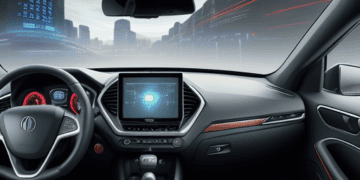As the automotive industry transitions towards electric and digitally integrated vehicles, cybersecurity has become a crucial concern for both manufacturers and consumers. Recent incidents, such as the hacking of vehicle security systems and thefts exploiting technological vulnerabilities, highlight these emerging challenges. In 2022, instances were reported where thieves compromised vehicles by manipulating the CAN bus system, showcasing the need for heightened security measures. Forrester Research has delved into the cybersecurity implications of software-defined vehicles (SDVs). The report explores how these vehicles, integral parts of a digital ecosystem, might be susceptible to various security risks.
A notable concern is the potential for breaches in a vehicle’s system to extend to other connected devices, such as the owner’s smartphone. Francesca Forestieri, Automotive Lead at GlobalPlatform, emphasizes that the shift to SDVs does not necessarily equate to an increased likelihood of hacking. However, she acknowledges that the scope for cyber-attacks has broadened, originating not just from traditional areas like telematics but also from new sources including vehicle owners and external charging systems. The user’s role in vehicle security is increasingly significant, mirroring the dynamics of IoT devices. Forestieri notes that while vehicle security is not solely the owner’s responsibility, user data protection and cautious use of services and applications are vital elements in the overall security framework.
Forestieri advocates for a paradigm shift in automotive cybersecurity approaches, moving away from the traditional walled-garden model. She supports the adoption of a zero-trust model, where each component is treated as potentially untrustworthy and interactions are based on a principle of least privilege. Certification of components within the SDV ecosystem is deemed crucial by Forestieri. This process would establish the security robustness of components and ensure transparency. Such certifications, typically undertaken by semiconductor providers, would apply universally across all products using those components. The legal responsibility for cybersecurity compliance primarily rests with automakers.
Forestieri observes a shift in industry practices, with automakers increasingly establishing direct relationships with semiconductor providers to ensure cohesive security measures. This collaboration marks a significant change from previous practices where security solutions were often proprietary and lacked comparability across products. Flexibility in security services is also highlighted as a key component of effective cybersecurity strategies. Past limitations in over-the-air updates restricted the adaptability of security services, leading to outdated solutions in vehicles with long service lives. Planning for future-proof security services, which can adapt and evolve over time, is essential in addressing the dynamic nature of cybersecurity threats. In summary, as software-defined vehicles become more prevalent, the automotive industry faces the challenge of developing robust, flexible, and transparent cybersecurity strategies to protect against evolving digital threats.
Stay current with supply chain report news at The Supply Chain Report. For international trade resources, visit ADAMftd.com.
#AutomotiveCybersecurity #ElectricVehicles #SoftwareDefinedVehicles #VehicleSecurity #CyberThreats #ConnectedCars #ZeroTrustModel #DigitalSecurity #IoTSecurity #AutomotiveIndustry #CyberCompliance #OverTheAirUpdates #VehicleDataProtection #SemiconductorSecurity #CyberRiskManagement #FutureProofSecurity #SDVChallenges #AutomakerCollaboration #SecurityCertification #CarHacking #TechnologyVulnerabilities

















